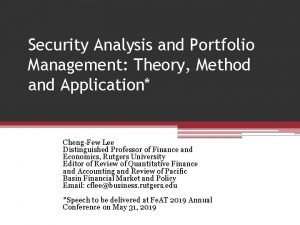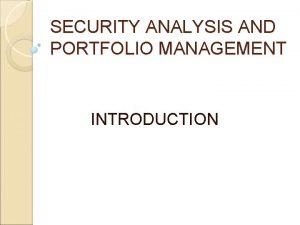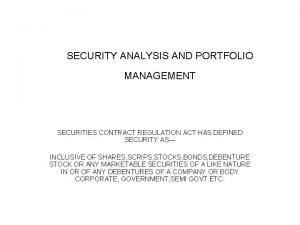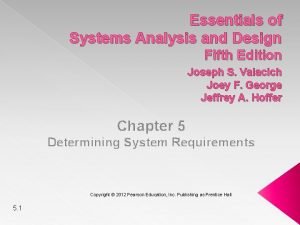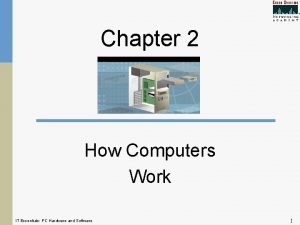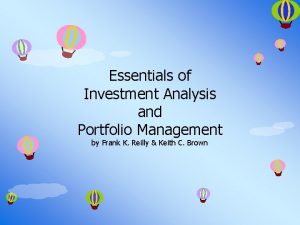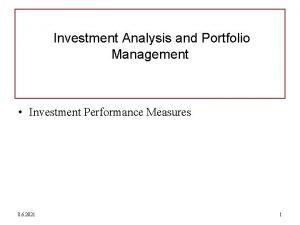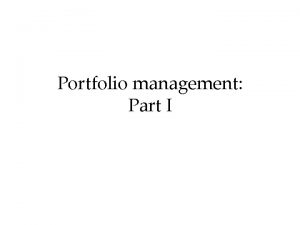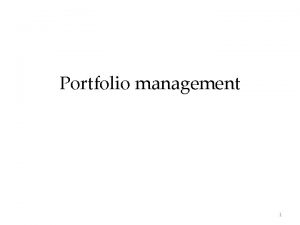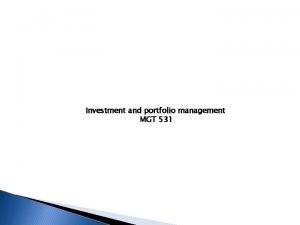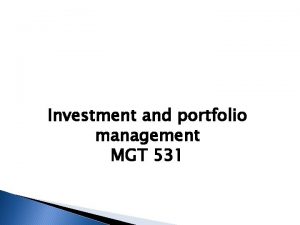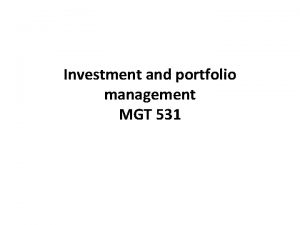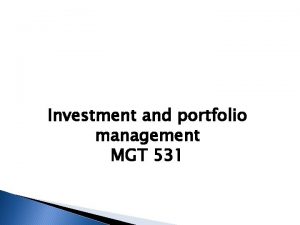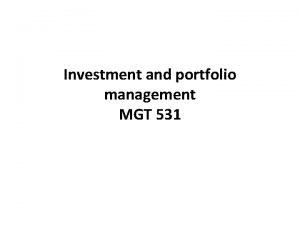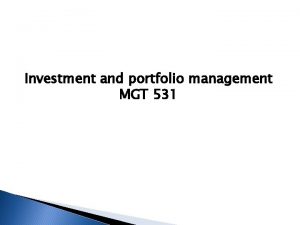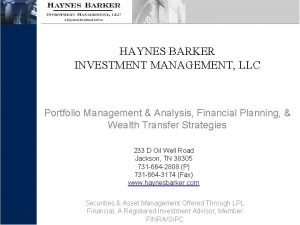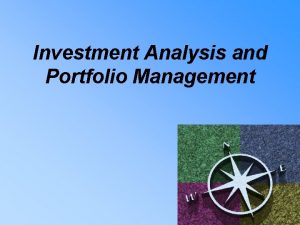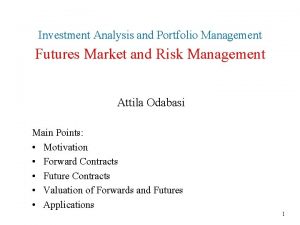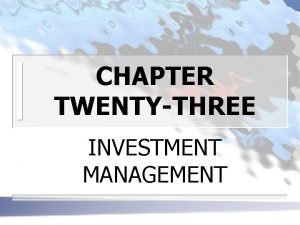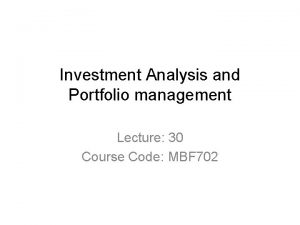Essentials of Investment Analysis and Portfolio Management Chapter










































- Slides: 42

Essentials of Investment Analysis and Portfolio Management Chapter 3 - Organization and Functioning of Securities Markets Frank K. Reilly & Keith C. Brown Chapter 3 Organization and Functioning of Securities Markets 1

Essentials of Investment Analysis and Portfolio Management Chapter 3 - Organization and Functioning of Securities Markets Frank K. Reilly & Keith C. Brown What is a market? • Brings buyers and sellers together to aid in the transfer of goods and services. – Does not require a physical location. – The market does not necessarily own the goods or services involved. – A market can deal in any variety of goods and services. 2

Essentials of Investment Analysis and Portfolio Management Chapter 3 - Organization and Functioning of Securities Markets Frank K. Reilly & Keith C. Brown Characteristics of a Good Market • Provide timely and accurate information • Liquidity – Marketability (likelihood of being sold quickly) – price continuity – Depth (many participants) • Low transaction costs (internal efficiency) • Rapid adjustment of prices to new information (external efficiency/informational efficiency) 3

Essentials of Investment Analysis and Portfolio Management Chapter 3 - Organization and Functioning of Securities Markets Frank K. Reilly & Keith C. Brown Decimal pricing • Stocks are quoted in eighths prior to 1997 (1/8, 2/8, …) • In 1997, they used sixteenths (1/16, 2/16, …) in the US. • In April 2001, NYSE, AMEX and NSADAQ all use decimal pricing. 4

Essentials of Investment Analysis and Portfolio Management Chapter 3 - Organization and Functioning of Securities Markets Frank K. Reilly & Keith C. Brown Benefits of using decimal pricing • Easily understood • Reduce bid-ask spread (minimum change from $0. 125, to $0. 0625, and to any small number)=> save money (bid-ask spread is the compensation to dealer) • More comparable with other exchanges => lower transaction costs and more competitive 5

Essentials of Investment Analysis and Portfolio Management Chapter 3 - Organization and Functioning of Securities Markets Frank K. Reilly & Keith C. Brown Organization of the Securities Market • Primary markets – Market where new securities are sold, and funds go to issuer. • Secondary markets – Market where outstanding securities are bought and sold by investors. The issuer does not receive any funds in a secondary market transaction. 6

Essentials of Investment Analysis and Portfolio Management Chapter 3 - Organization and Functioning of Securities Markets Frank K. Reilly & Keith C. Brown Primary Capital Markets Government Bond Issues 1. Treasury Bills – negotiable, non-interest bearing securities with original maturities of one year or less 2. Treasury Notes – original maturities of 2 to 10 years 3. Treasury Bonds – original maturities of more than 10 years 7

Essentials of Investment Analysis and Portfolio Management Chapter 3 - Organization and Functioning of Securities Markets Frank K. Reilly & Keith C. Brown Municipal Bond Issues • Sold by three methods – Competitive bid (require underwriters) – Negotiation (require underwriters) – Private placement • Underwriters sell the bonds to investors – Origination – Risk-bearing – Distribution 8

Essentials of Investment Analysis and Portfolio Management Chapter 3 - Organization and Functioning of Securities Markets Frank K. Reilly & Keith C. Brown The Underwriting Function • The investment banker purchases the entire issue from the issuer and resells the security to the investing public. • The firm charges a commission for providing this service. • For municipal bonds, the underwriting function is performed by both investment banking firms and commercial banks. 9

Essentials of Investment Analysis and Portfolio Management Chapter 3 - Organization and Functioning of Securities Markets Frank K. Reilly & Keith C. Brown The Underwriting Organization Structure (Corporate bond issues) Exhibit 3. 1 10

Essentials of Investment Analysis and Portfolio Management Chapter 3 - Organization and Functioning of Securities Markets Frank K. Reilly & Keith C. Brown Corporate Stock Issues New issues (typically underwritten by investment bankers) are divided into two groups 1. Seasoned new issues - new shares offered by firms that already have stock outstanding 2. Initial public offerings (IPOs) - a firm selling its common stock to the public for the first time 11

Essentials of Investment Analysis and Portfolio Management Chapter 3 - Organization and Functioning of Securities Markets Frank K. Reilly & Keith C. Brown Underwriting Relationships with Investment Bankers 1. Negotiated – Most common – Full services of underwriter 2. Competitive bids – Investment bankers give less advice – Lower costs – Reduced services of underwriter 3. Best-efforts – Investment banker acts as broker 12

Essentials of Investment Analysis and Portfolio Management Chapter 3 - Organization and Functioning of Securities Markets Frank K. Reilly & Keith C. Brown Secondary Financial Markets Why secondary financial markets are important? 1. Provides liquidity to investors who acquire securities in the primary market. 2. Lower required returns because of lower liquidity risk. 3. Helps in pricing the new issues. 13

Essentials of Investment Analysis and Portfolio Management Chapter 3 - Organization and Functioning of Securities Markets Frank K. Reilly & Keith C. Brown Secondary Bond Market • Secondary market for U. S. government and municipal bonds (active trading) – U. S. government bonds traded by bond dealers (large banks and investment banks) – Banks and investment firms make up municipal market makers – Large investment firms also underwrite and trade municipal bonds • Secondary corporate bond market (limited trading) – Currently traded in OTC market 14

Essentials of Investment Analysis and Portfolio Management Chapter 3 - Organization and Functioning of Securities Markets Frank K. Reilly & Keith C. Brown Secondary Equity Markets 1. Major national stock exchanges (listed securities exchanges) – New York, American, Tokyo, and London stock exchanges 2. Regional stock exchanges (listed securities exchanges) – Chicago, San Francisco, Boston, Osaka, Nagoya, Dublin, Cincinnati 3. Over-the-counter (OTC) market – Stocks not listed on organized exchange 15

Essentials of Investment Analysis and Portfolio Management Chapter 3 - Organization and Functioning of Securities Markets Frank K. Reilly & Keith C. Brown 2 major trading systems • Pure auction market – Buyers and sellers are matched by a broker at a central location – Price-driven market • Dealer market – Dealers provide liquidity by buying and selling shares – Dealers may compete against other dealers 16

Essentials of Investment Analysis and Portfolio Management Chapter 3 - Organization and Functioning of Securities Markets Frank K. Reilly & Keith C. Brown Call versus Continuous Markets • Call markets trade individual stocks at specified times. This occurs when: – In the early stage of an exchange, few stocks listed and few traders – orders build up overnight – after trading is suspended. • Call markets make themselves more orderly and less volatile. 17

Essentials of Investment Analysis and Portfolio Management Chapter 3 - Organization and Functioning of Securities Markets Frank K. Reilly & Keith C. Brown Call versus Continuous Markets • In a continuous market, trades occur at any time the market is open, priced by auction or by dealers. • Combination structure: auction market basically and intermediary (broker or dealer) appears if the auction market has few activities. 18

Essentials of Investment Analysis and Portfolio Management Chapter 3 - Organization and Functioning of Securities Markets Frank K. Reilly & Keith C. Brown National Stock Exchanges • • Large number of listed securities Prestige of firms listed Wide geographic dispersion of listed firms Diverse clientele of buyers and sellers 19

Essentials of Investment Analysis and Portfolio Management Chapter 3 - Organization and Functioning of Securities Markets Frank K. Reilly & Keith C. Brown skip The introduction to the following stock exchanges is skipped. Read these pages (pp 76 -82) • • • NYSE AMEX Tokyo Stock Exchange London Stock Exchange Regional stock exchanges 20

Essentials of Investment Analysis and Portfolio Management Chapter 3 - Organization and Functioning of Securities Markets Frank K. Reilly & Keith C. Brown OTC market • A negotiated market (investors negotiate directly with dealers) • The largest segment of the US secondary market in terms of the number of issues traded. (NYSE has a larger total value of trading. ) • Any security can be traded in OTC (no minimum requirement) as long as a registered dealer wants to make a market. • The securities include more than 100 exchangelisted stocks and government bonds.

Essentials of Investment Analysis and Portfolio Management Chapter 3 - Organization and Functioning of Securities Markets Frank K. Reilly & Keith C. Brown Third Market • OTC trading of shares listed on an exchange • Mostly well known stocks – GM, IBM, AT&T, Xerox • Competes with trades on exchanges • May be open when the stock exchange is closed or trading suspended. 22

Essentials of Investment Analysis and Portfolio Management Chapter 3 - Organization and Functioning of Securities Markets Frank K. Reilly & Keith C. Brown Fourth Market • Direct trading of securities between two parties with no broker intermediary • Usually both parties are institutions • Can save transaction costs • No data are available regarding its specific size and growth 23

Essentials of Investment Analysis and Portfolio Management Chapter 3 - Organization and Functioning of Securities Markets Frank K. Reilly & Keith C. Brown Detailed Analysis of Exchange Markets • Exchange Membership • Major Types of Orders • Exchange Market Makers 24

Essentials of Investment Analysis and Portfolio Management Chapter 3 - Organization and Functioning of Securities Markets Frank K. Reilly & Keith C. Brown Exchange Membership 1. Specialist (market maker, introduced later) 2. Commission brokers – Employees of a member firm who buy or sell for the customers of the firm 3. Floor brokers – Independent members of an exchange who act as broker for other members (to earn service fees) 4. Registered traders – Use their membership to buy and sell for their own accounts (they add liquidity but their trading obligations are limited) 25

Essentials of Investment Analysis and Portfolio Management Chapter 3 - Organization and Functioning of Securities Markets Frank K. Reilly & Keith C. Brown Major Types of Orders • Market orders – Buy at the lowest offering price available – Sell at the highest bid available – Provides immediate liquidity • Limit orders – Order specifies the buy or sell price – Time specifications for order may vary • Instantaneous - “fill or kill”, part of a day, a full day, several days, a week, a month, or good until canceled (GTC) 26

Essentials of Investment Analysis and Portfolio Management Chapter 3 - Organization and Functioning of Securities Markets Frank K. Reilly & Keith C. Brown Major Types of Orders • Short sales – Sell overpriced stock that you don’t own and purchase it back later (at a lower price) – Borrow the stock from another investor (through your broker) – Can only be made on an uptick trade – Must pay any dividends to lender – Margin requirements apply 27

Essentials of Investment Analysis and Portfolio Management Chapter 3 - Organization and Functioning of Securities Markets Frank K. Reilly & Keith C. Brown Major Types of Orders • Special Orders – Stop loss • Conditional order to sell stock if it drops to a given price • Does not guarantee price you will get upon sale • Market disruptions cancel such orders – Stop buy order • Investor who sold short may want to limit loss if stock increases in price 28

Essentials of Investment Analysis and Portfolio Management Chapter 3 - Organization and Functioning of Securities Markets Frank K. Reilly & Keith C. Brown Margin Transactions • On any type of order, instead of paying 100% cash, borrow a portion of the transaction, using the stock as collateral. • Interest rate on margin credit typically is 1. 5% above the call money rate (banks). • Initial margin requirement was 50% (July 2002, the Fed) 29

Essentials of Investment Analysis and Portfolio Management Chapter 3 - Organization and Functioning of Securities Markets Frank K. Reilly & Keith C. Brown Margin Transactions Buy 200 shares at $50 = $10, 000 position Borrow 50%, investment of $5, 000 If price increases to $60, position – Value is $12, 000 – Less - $5, 000 borrowed – Leaves $7, 000 equity for a – $7, 000/$12, 000 = 58% equity position 30

Essentials of Investment Analysis and Portfolio Management Chapter 3 - Organization and Functioning of Securities Markets Frank K. Reilly & Keith C. Brown Margin Transactions Buy 200 shares at $50 = $10, 000 position Borrow 50%, investment of $5, 000 If price decreases to $40, position – Value is $8, 000 – Less - $5, 000 borrowed – Leaves $3, 000 equity for a – $3, 000/$8, 000 = 37. 5% equity position 31

Essentials of Investment Analysis and Portfolio Management Chapter 3 - Organization and Functioning of Securities Markets Frank K. Reilly & Keith C. Brown Leverage factor • Leverage factor= 1/margin(%) – For example: 50% margin, then leverage factor=1/50%=2 – When stock price increase (decreases) 20%, your equity increases (decreases) 20%*2=40% See page 91 for considerations on transaction costs 32

Essentials of Investment Analysis and Portfolio Management Chapter 3 - Organization and Functioning of Securities Markets Frank K. Reilly & Keith C. Brown Margin Transactions • Initial margin requirement at least 50%. Set up by the Fed. • Maintenance margin – – Requirement proportion of equity to stock Protects broker if stock price declines Minimum requirement is 25% Margin call on undermargined account to meet margin requirement – If margin call not met, stock will be sold to pay off the loan 33

Essentials of Investment Analysis and Portfolio Management Chapter 3 - Organization and Functioning of Securities Markets Frank K. Reilly & Keith C. Brown Margin call • Using the prior example, let’s determine the stock price below which you will receive a margin call: (margin requirement is 25%) 34

Essentials of Investment Analysis and Portfolio Management Chapter 3 - Organization and Functioning of Securities Markets Frank K. Reilly & Keith C. Brown Exchange Market Makers (U. S. Markets) • Specialist is exchange member assigned to handle particular stocks (about 15 stocks) – Has two major roles: 1. Broker to match buyers and sellers 2. Dealer to maintain fair and orderly market (about 15%~30% of the trades on NYSE) • Specialist has two income sources 1. Broker commission, without risk (for very liquid stocks) 2. Dealer trading income from profit, with risk (for less liquid stocks) 35

Essentials of Investment Analysis and Portfolio Management Chapter 3 - Organization and Functioning of Securities Markets Frank K. Reilly & Keith C. Brown Changes in the Securities Markets • Since 1965, the growth of trading by large financial institutions (institutionalization) has had many effects: – Negotiated (competitive) commission rates – Influence on block trades – Impact on stock price volatility – Development of National Market System (NMS) 36

Essentials of Investment Analysis and Portfolio Management Chapter 3 - Organization and Functioning of Securities Markets Frank K. Reilly & Keith C. Brown Negotiated Commission Rates • NYSE minimum commission schedule prohibited price cutting since 1792 • No price break for large orders – Initial reaction was “give-ups” paid to a designated firm - soft dollars paid for market research – Third market competed with flexible commissions and grew – Fostered development of the fourth market 37

Essentials of Investment Analysis and Portfolio Management Chapter 3 - Organization and Functioning of Securities Markets Frank K. Reilly & Keith C. Brown Negotiated Commission Rates • In 1970 SEC began phasing in negotiated commissions – Commission rates have fallen – Discount brokerage firms compete openly – Many brokerage and research firms have merged or liquidated (buying research by using soft dollars) 38

Essentials of Investment Analysis and Portfolio Management Chapter 3 - Organization and Functioning of Securities Markets Frank K. Reilly & Keith C. Brown The Impact of Block Trades • Number and size of block trades has increased • This strains the exchange specialist system – Capital - 10, 000 shares or larger blocks – Commitment - large risk with large blocks – Contacts - Rule 113 prohibited direct contact to offer blocks to another institution 39

Essentials of Investment Analysis and Portfolio Management Chapter 3 - Organization and Functioning of Securities Markets Frank K. Reilly & Keith C. Brown The Impact of Block Trades • • Block houses (upstairs traders) are investment firms that help institutions locate other institutions interested in buying or selling blocks of stock A good block house has 1. 2. 3. The capital required to position a large block The willingness to commit this capital to a block transaction, and Contacts among institutions 40

Essentials of Investment Analysis and Portfolio Management Chapter 3 - Organization and Functioning of Securities Markets Frank K. Reilly & Keith C. Brown Institutions and Stock Price Volatility • Empirical studies have not supported theory that institutional trading increases price volatility. • Where trading is dominated by institutions, actively involved institutions may provide liquidity for one another and noninstitutional investors. 41

Essentials of Investment Analysis and Portfolio Management Chapter 3 - Organization and Functioning of Securities Markets Frank K. Reilly & Keith C. Brown Exercises • Do Problem 2, 4, 5, 7 42
 Investment analysis and portfolio management notes for mba
Investment analysis and portfolio management notes for mba Scope of investment analysis and portfolio management
Scope of investment analysis and portfolio management Investment analysis and portfolio management course
Investment analysis and portfolio management course Investment analysis & portfolio management
Investment analysis & portfolio management Fixed investment and inventory investment
Fixed investment and inventory investment Security analysis and portfolio management project
Security analysis and portfolio management project Security analysis and portfolio management project
Security analysis and portfolio management project Importance of security analysis and portfolio management
Importance of security analysis and portfolio management Risk in security analysis and portfolio management
Risk in security analysis and portfolio management Essentials of systems analysis and design
Essentials of systems analysis and design Values in nursing profession ppt
Values in nursing profession ppt Example of portfolio in science
Example of portfolio in science Essentials of migration management
Essentials of migration management Essentials of database management
Essentials of database management Purdue project management essentials
Purdue project management essentials Essentials of migration management
Essentials of migration management Essentials of migration management
Essentials of migration management Essentials of mis, 13th edition
Essentials of mis, 13th edition Evergreen nirvana
Evergreen nirvana It essentials chapter 8
It essentials chapter 8 What are the essentials of a successful ffa chapter
What are the essentials of a successful ffa chapter It essential chapter 9
It essential chapter 9 It essentials
It essentials It essential chapter 12
It essential chapter 12 It essentials chapter 11
It essentials chapter 11 Business essentials 12th edition
Business essentials 12th edition Marketing essentials chapter 38
Marketing essentials chapter 38 Chapter 13 initiating the sale answer key
Chapter 13 initiating the sale answer key Form utilities
Form utilities It essential chapter 5
It essential chapter 5 It essentials chapter 3
It essentials chapter 3 It essentials chapter 11
It essentials chapter 11 Essentials of social media marketing chapter 9 quiz
Essentials of social media marketing chapter 9 quiz It essentials chapter 7
It essentials chapter 7 It essentials chapter 6
It essentials chapter 6 It essentials chapter 5
It essentials chapter 5 It essentials chapter 4
It essentials chapter 4 Chapter 4 kitchen essentials 1 answers
Chapter 4 kitchen essentials 1 answers It essentials chapter 2
It essentials chapter 2 It essential chapter 5
It essential chapter 5 Cisco it essentials virtual desktop download free
Cisco it essentials virtual desktop download free It essentials chapter 10
It essentials chapter 10 It essentials chapter 10
It essentials chapter 10





